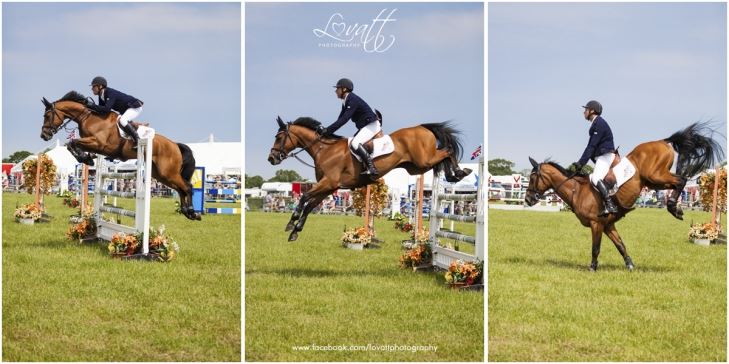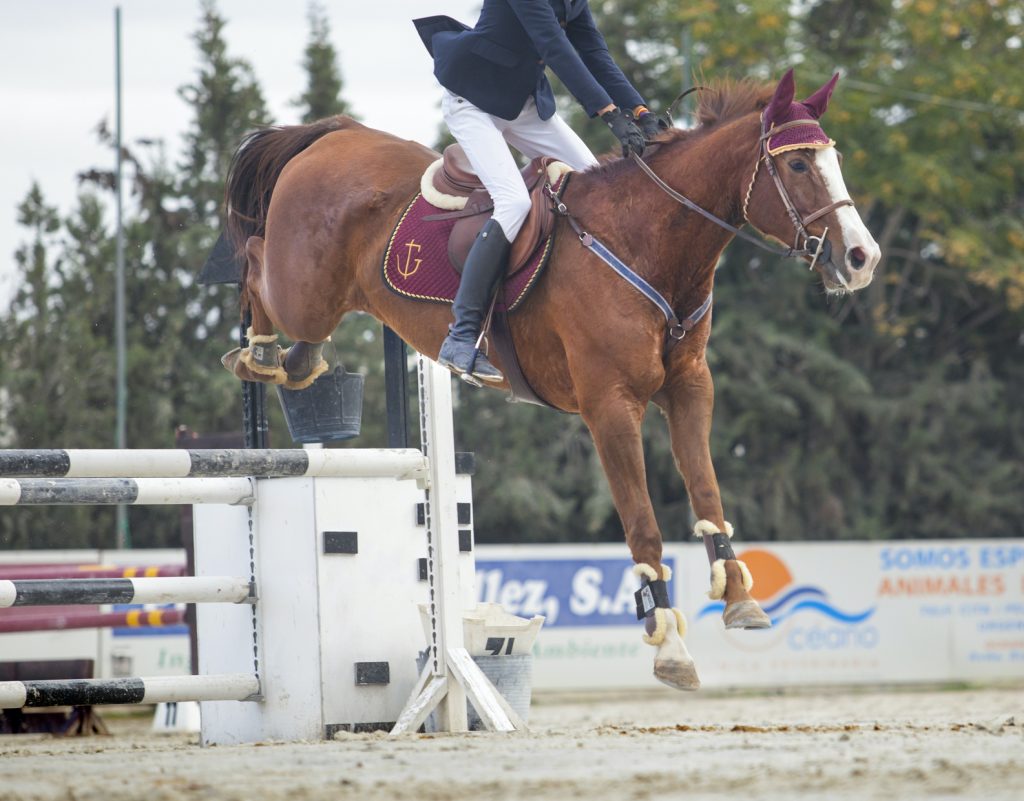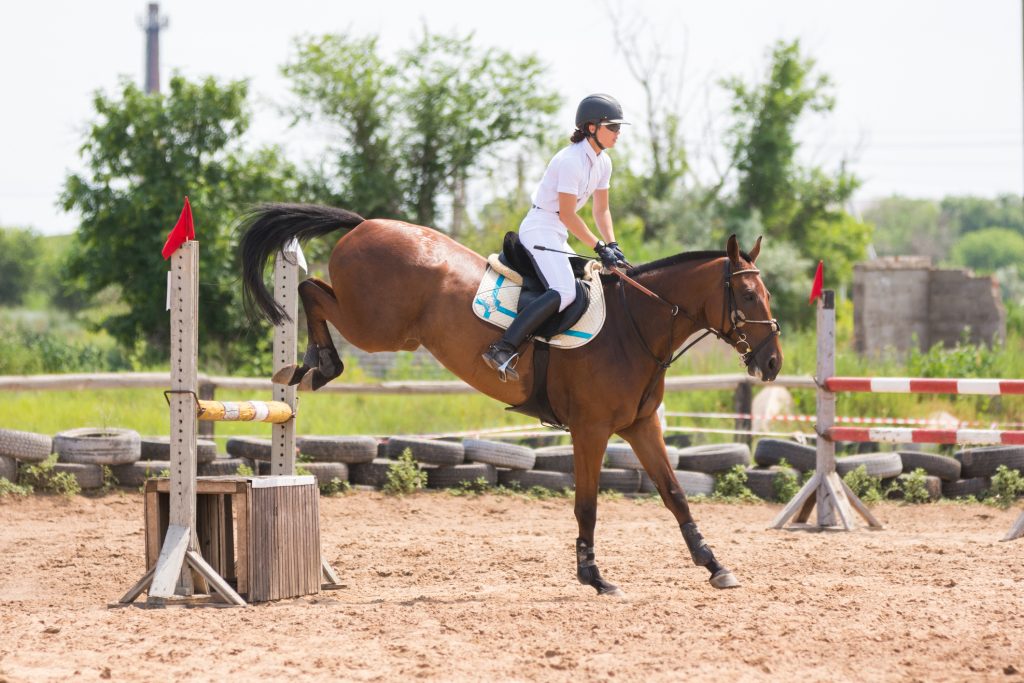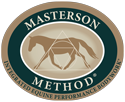By Coralie Hughes MMCP Coach and Instructor

Last month we looked at the first part of an analysis of the biomechanics of jumping. The jump was broken into the Approach, Take-off, Suspension and Landing phases. In Part 1 we looked at the Approach and Take-off phases. This month we’ll see the horse finish the jump as we look at the Suspension and Landing phases, and we’ll also address which Masterson Method Techniques work well for jumpers, and why.
The Suspension Phase
To bascule (round the back) over the fence, the horse has to lower his head and raise his withers (thoracic sling). The shape of the horse’s head, neck and back forms the bascule. In the air, the horse’s body rotates around his center of gravity. The trapezius, brachiocephalic and latissimus dorsi muscles contract to flex the shoulder and elbow joints and lift the scapulae. This helps lift the forelimbs to attain the necessary height to clear the jump.
The folded forelegs bring the horse’s weight closer to his center of gravity, which increases speed. Tension on the nuchal and supraspinous ligaments (run from the poll to the sacrum along the topline of the neck and the back) also helps to raise the center of gravity further to increase height because the head and neck are extended forward and down.
Just after the bascule of the jump, the head and neck start to come up which shifts the center of gravity back. This signals for the hind limbs to flex in order to clear the jump and to extend the forelimbs in preparation for landing. As the forelimbs extend for landing, the abdominal muscles contract to help lift the back while the gluteals and other muscles flex the hips, hocks and stifles to clear the jump.
The Landing Phase
The front limbs take the full weight of the horse as it lands. The thoracic sling (especially the pectoral muscles) plays a crucial concussive role that protects the musculoskeletal system as well as the vital organs encased in the ribcage. If the thoracic sling isn’t free, the front-end lands hard without the shock absorber action that is needed.
As the horse is preparing to land after the jump, the horse must lift his head and neck up to shift the body weight back and slow down the rotation of the body axis, thus ensuring good balance on landing. The trailing fore limb tends to be perpendicular to the ground (it lands first because the horse is cantering) and absorbs most of the impact (up to 2 ½ times the body weight of the horse). The suspensory ligament and the deep digital flexor tendon are stretched to the extent that the fetlock often touches the ground. Strain is put on the navicular bone via the deep digital flexor tendon as the horse lands on his heel with the toe turned upwards. The trailing forelimb quickly rebounds off the ground.
As the front legs touch the ground, the thoracic sling along with all the muscles of the forelimbs contract to brace the leg and support the joints. As the forefeet touch the ground after the jump, they push the body up into the next canter stride. This reverses the rotation of the body axis and allows the hind legs to step under the body to canter on.

Masterson Method Techniques for Jumpers
Now it’s time to look at Masterson Method Techniques that work well for jumpers. Most techniques are taught in the Weekend Seminar, however Advanced 5-Day Techniques are marked with a *.
Jumping at high levels of competition is especially demanding on the horse’s musculo-skeletal system. Excessive muscular tension in any of the structures mentioned in this review of the biomechanics of jumping disables the normal muscular ability to fully contract and fully relax. Without the normal ability to contract and relax, the muscles are less effective in acting on the skeleton to move the body as required for performance. An unhealthy musculature can result in compensatory patterns of movement which increase the strain on the musculo-skeletal system of the horse: joints, muscles, tendons and ligaments.
The Importance of Mobility
In bodywork, we are concerned with the mobility requirements in jumping. Mobility of the frontend needs to be equal to the left and to the right; the neck must be able to raise and lower and to extend; and the atlanto-occipital joint must be able to open and the nose must be able to extend out.
The thoracic sling and joints of the forelimb must be free: the forelegs must be able to fully extend out to the front, opening or straightening all the joints of the foreleg; the shoulder must be able to horizontalize; all the joints of the foreleg must also be able to maximally close, including the elbow, knees require full mobility and to be free of splint pain; the ankles (including sesamoid bones) require maximal mobility; and the chest and withers need to be able to lift between the front legs as well as sink.
The bascule movement and landing phase require mobility of the back and joints of the hindlimb to be free: when the head goes down, the back needs to be able to come up and round; the lumbar spine must be able to round to a greater degree than the thorax, and the lumbo-sacral joint must be free for maximal contraction and also extension; the joints of the hind leg (hip, stifle and hock) must be free for maximum contraction as well as maximum extension; and the hind fetlocks must have the utmost mobility as with the front fetlocks.
The horse must have lateral suppleness for bending onto a new line. He must have the longitudinal suppleness to shift weight front to back on a moment’s notice for speed adjustments as well as preparing for take-off. Longitudinal suppleness also enables the critical bascule over the jump. Incidentally, lateral suppleness is necessary to produce longitudinal suppleness. And don’t forget the tail! It must be able to be carried straight and flick expressively over the jump!
The Job of Muscles
Forgive me you anatomy gurus out there, but keeping it simple for application of jumping biomechanics to bodywork. The muscles have to be able to do five things:
- contract to close a joint or bend a body region,
- relax on one side to allow movement (contraction) of a joint or bend of a body region on the other side,
- hold a joint or body region in a certain angulation or position,
- explosively extend or open the joints, and
- absorb shock.
My Bodywork Notes
Here are some notes from my personal bodywork experience with jumpers/eventers.
If the topline is tight (hard contracted topline of the neck, overdeveloped under-neck, dropped back, difficulty with putting his head down) the jumper can’t use his neck and head in a bascule. If the thoracic sling is likewise restricted and isn’t free to lift between the shoulders (the top of the withers relative to the top of the scapula raises) the poor horse has a real dilemma when going over a fence: he can’t lift his knees and his withers at the same time. It is one or the other and the horse either hits fences with his knees if he squeaks out a bascule or he lifts his knees but can’t round his back and jumps very flat and can only manage low fences.
This is a very common presentation and is a likely recipe for a dirty stopper. He knows he can’t do it. The entire neck and back topline of this horse must be released as well as the shoulders and thoracic sling. The pectoral muscles of this horse are likely very tight and sore since the pectorals are the main shock absorber for the front end. (Caution! Horses typically nip when a sore pectoral muscle is touched.) Tight pectorals are major culprits in restricting the thoracic sling.
Since this horse travels with his head in the air, his back is often dropped. If chronically dropped due to tightness, the lumbo-sacral joint is strained and fixed which prevents the lumbar from rounding. This means the horse can’t bring the hind legs far enough under for a good jump. This puts extra strain on the joints of the hind legs and on down to the tendons and ligaments of the lower leg. When you think about it, the whole mechanism is straining against itself. This is a frequent cause of damage to vital soft tissue structures.

As a side note, 60% of career ending injuries in performance horses involve soft tissue (tendons and ligaments) likely due to excessive negative tension in the muscles connected to those structures. The Masterson Method Techniques used to relieve stress on the soft tissue would be the Bladder Meridian (learned in the Weekend Seminar) and Accordions (learned in the Advanced 5-Day Course) which can be used regularly and during competition.
Additionally, jumpers and eventers are frequently extremely stiff laterally in their bodies and necks. This inhibits the ability to make quick turns and the ability to gain longitudinal suppleness which allows for a good bascule over the jump.
Fortunately, using the entire Masterson Method toolbox, including new techniques taught in the Certification Completion Course (for those seeking certification as a practitioner), this horse can be freed up so that he can learn to properly use his body. It might take a couple sessions to get there, but the horse will be the healthier for it!
Learn more about how to work with Hunters and Jumpers on page 181 of the Beyond Horse Massage Book, or sign up for a Weekend Seminar to get started with your Masterson Method journey.
Photo credit kindly to Lovatt Pet Photography and Clarence Alford
